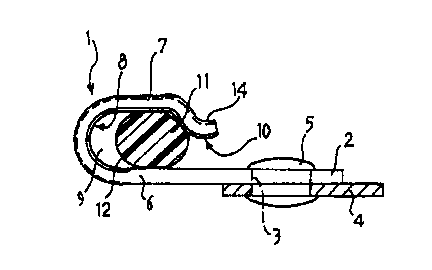Some of the information on this Web page has been provided by external sources. The Government of Canada is not responsible for the accuracy, reliability or currency of the information supplied by external sources. Users wishing to rely upon this information should consult directly with the source of the information. Content provided by external sources is not subject to official languages, privacy and accessibility requirements.
Any discrepancies in the text and image of the Claims and Abstract are due to differing posting times. Text of the Claims and Abstract are posted:
| (12) Patent Application: | (11) CA 2304053 |
|---|---|
| (54) English Title: | A LACING HOOK FOR LACED FASTENINGS |
| (54) French Title: | CROCHET DE LACAGE POUR ELEMENTS DE FIXATION LACES |
| Status: | Deemed Abandoned and Beyond the Period of Reinstatement - Pending Response to Notice of Disregarded Communication |
| (51) International Patent Classification (IPC): |
|
|---|---|
| (72) Inventors : |
|
| (73) Owners : |
|
| (71) Applicants : |
|
| (74) Agent: | OYEN WIGGS GREEN & MUTALA LLP |
| (74) Associate agent: | |
| (45) Issued: | |
| (86) PCT Filing Date: | 1998-09-03 |
| (87) Open to Public Inspection: | 1999-04-01 |
| Availability of licence: | N/A |
| Dedicated to the Public: | N/A |
| (25) Language of filing: | English |
| Patent Cooperation Treaty (PCT): | Yes |
|---|---|
| (86) PCT Filing Number: | PCT/EP1998/005593 |
| (87) International Publication Number: | EP1998005593 |
| (85) National Entry: | 2000-03-15 |
| (30) Application Priority Data: | ||||||
|---|---|---|---|---|---|---|
|
A lacing hook for laced fastenings is described and comprises a first cheek
(6) and a second cheek (7) disposed opposite one another and defining between
them a channel (8) with a base surface (9) defining a lacing surface for the
hook, the base of the channel (8) being formed integrally with the lacing hook
and the base surface (9) of the channel having a substantially toroidal shape.
L'invention porte sur un crochet de laçage pour éléments de fixation lacés, ce crochet comprenant un premier rebord (6) opposé à un second rebord (7), ces deux rebords formant entre eux un canal (8) doté d'une surface de base (9) formant une surface de laçage du crochet. La base du canal (8) fait partie intégrante du crochet de laçage et la surface de base (9) du canal est de forme pratiquement toroïdale.
Note: Claims are shown in the official language in which they were submitted.
Note: Descriptions are shown in the official language in which they were submitted.

2024-08-01:As part of the Next Generation Patents (NGP) transition, the Canadian Patents Database (CPD) now contains a more detailed Event History, which replicates the Event Log of our new back-office solution.
Please note that "Inactive:" events refers to events no longer in use in our new back-office solution.
For a clearer understanding of the status of the application/patent presented on this page, the site Disclaimer , as well as the definitions for Patent , Event History , Maintenance Fee and Payment History should be consulted.
| Description | Date |
|---|---|
| Application Not Reinstated by Deadline | 2004-09-03 |
| Time Limit for Reversal Expired | 2004-09-03 |
| Deemed Abandoned - Failure to Respond to Maintenance Fee Notice | 2003-09-03 |
| Inactive: Abandon-RFE+Late fee unpaid-Correspondence sent | 2003-09-03 |
| Inactive: Entity size changed | 2002-08-21 |
| Inactive: Cover page published | 2000-06-09 |
| Inactive: First IPC assigned | 2000-06-06 |
| Inactive: Notice - National entry - No RFE | 2000-05-11 |
| Application Received - PCT | 2000-05-08 |
| Application Published (Open to Public Inspection) | 1999-04-01 |
| Abandonment Date | Reason | Reinstatement Date |
|---|---|---|
| 2003-09-03 |
The last payment was received on 2002-07-29
Note : If the full payment has not been received on or before the date indicated, a further fee may be required which may be one of the following
Patent fees are adjusted on the 1st of January every year. The amounts above are the current amounts if received by December 31 of the current year.
Please refer to the CIPO
Patent Fees
web page to see all current fee amounts.
| Fee Type | Anniversary Year | Due Date | Paid Date |
|---|---|---|---|
| MF (application, 2nd anniv.) - small | 02 | 2000-09-05 | 2000-03-15 |
| Basic national fee - small | 2000-03-15 | ||
| MF (application, 3rd anniv.) - small | 03 | 2001-09-03 | 2001-07-30 |
| MF (application, 4th anniv.) - standard | 04 | 2002-09-03 | 2002-07-29 |
Note: Records showing the ownership history in alphabetical order.
| Current Owners on Record |
|---|
| TIZIANO GALLO |
| RINO BISSACCO |
| Past Owners on Record |
|---|
| None |